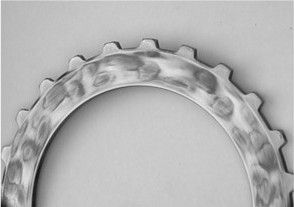HotSpotter Home | Background | Features | References | Demo | Download Demo |Purchasing Information
Background InformationA sliding system
such as automotive disk brake or transmission clutch involves two or more
sliding bodies which are nominally conforming over some contact area. An
imperfection might disturb the otherwise uniform pressure distribution
and hence the frictional heat generation. This produces non-uniform
thermoelastic distortion and further non-uniformity in the contact
pressure distribution. If the sliding speed is sufficiently high,
the thermal-mechanical feedback process is unstable, leading eventually
to the localization of the load in a small region of the nominal contact
area of the sliding surfaces. This phenomenon, generally known as
thermoelastic instability or TEI, was first discovered
and explained by Barber (1967, 1969) in sliding systems involving
frictional heating. TEI has long been recognized as imposing design
constraints on high performance systems such as aircraft brakes, but
interest in the phenomenon in the automotive industry is more recent,
being prompted by changes in braking materials and other design improvements.
In the HotSpotter, a finite element method is developed
for determining the critical sliding speed for TEI of an axisymmetric
clutch or brake. Linear perturbations on the constant speed solution
are sought that vary sinusoidally in the circumferential direction and
grow exponentially in time. These factors cancel in the governing
thermoelastic and heat conduction equations, leading to a linear
eigenvalue problem on the two-dimensional cross-sectional domain
for the exponential growth rate for each Fourier wave number. The
Fourier reduction method developed in HotSpotter permits a remarkably
efficient solution of the frictional thermoelastic stability problem
for systems in which the geometry is axisymmetric. The power of the method
is demonstrated by the multidisk clutch example, direct numerical
simulation of which would represent an extremely challenging computational
problem. Values are obtained for the critical sliding or rotational speed
and also for the exponential growth rate of each mode when operating above
the critical speed. The method is easily applied to other examples and can
therefore be used to assess the effect of design modifications such as
changes in geometry and material properties on the thermoelastic stability
of multidisk brakes and clutches.

HotSpotter
Home | Background | Features | References | Demo | Download
Demo |Purchasing Information

Copyright 2000 by the Regents of the
University of Michigan

